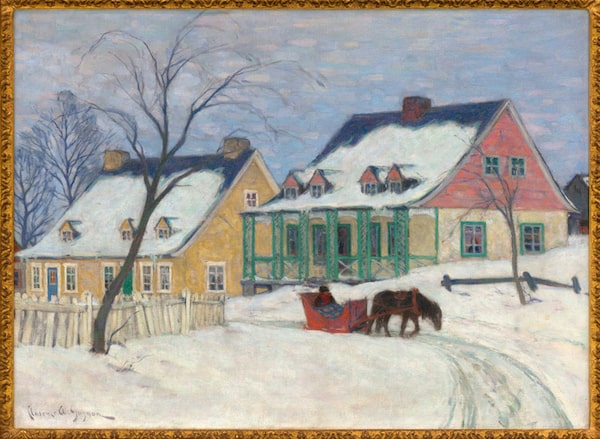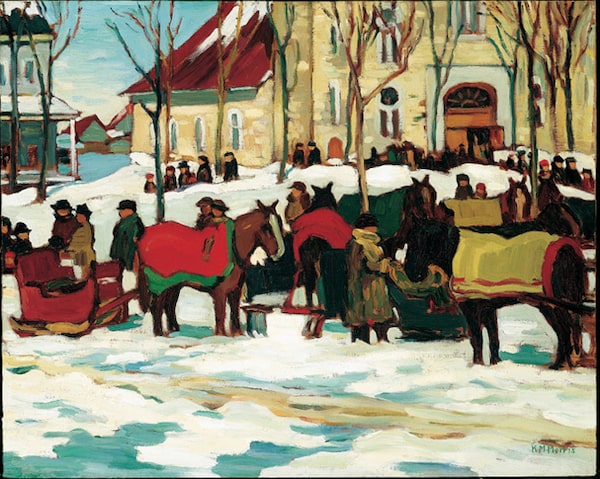
In the late 19th and early 20th centuries, a wave of Canadians migrated to France to learn the art of Impressionism. (Clarence Gagnon, Old Houses, Baie-Saint-Paul, c. 1912. Private Collection, Toronto.)Uberscan by Colourgenics/Courtesy of NGC
Roger Diederen, director of the Kunsthalle Munchen in Munich, Germany, said he got some inquisitive looks when his gallery announced it was going to host an exhibit of Canadian art this summer.
“What? Canadian Impressionism? Does that exist?” he said he was asked. “Even the Group of Seven is not well known here in Europe.” But that surprise turned to interest, which turned into delight, he said, when the thousands of audience members who have so far visited the art were able to take it in. “It’s a new perspective on this whole global phenomenon of Impressionism."
In the late 19th and early 20th centuries, a wave of Canadians migrated to France to learn the art of Impressionism. Now, more than a century later, work from Emily Carr, Helen McNicoll, Lawren Harris and others is returning to the continent that birthed it.

Impressionism was a movement that started in France in the early 1860s by Claude Monet and other Paris-based artists (Laura Muntz. The Pink Dress, 1897. Private Collection, Toronto.)Thomas Moore/Courtesy of NGC.
Canada and Impressionism: New Horizons, 1880-1930, is the first exhibit of its kind to tour Europe. The exhibition, from the National Gallery of Canada, is visiting galleries in Germany, Switzerland and France over the next year, before returning to Ottawa late in 2020.
Katerina Atanassova, the senior curator of Canadian art at the National Gallery and the creator of the exhibit, said her intent with the show – and the new research her team conducted along with it – was to show the world how Canada, too, was involved in the internationally influential Impressionist movement. “To me, this period is the most important period in the history of Canadian art,” she said.
Impressionism was a movement started in France in the early 1860s by Claude Monet and other Paris-based artists who sought to capture the impression of a scene by emphasizing light and colour over detail. Although critics first responded with derision, the movement caught on and spread globally. Artists from around the world – such as those featured in Canada and Impressionism – travelled to France for an education in the style, then brought their new knowledge back home.

Over the years, artists from around the world travelled to France for an education in Impressionism, then brought their new knowledge back home. (James Wilson Morrice, Luxembourg. Gardens, Paris, c. 1905.)NGC
Atanassova said the Canadian style of Impressionism is different due to our chillier northern environment. Impressionists are preoccupied with capturing the way sunlight fell naturally on objects, but the light of Canada was different from the warm glow of the Mediterranean. “Form remains solid here, because the light is harsher,” she said.
Another major difference had to do with logistics: for Canadian artists trying to capture a snowy outdoor scene in the depths of winter, there wasn’t a lot of time to work outside before their fingers froze. “Their compositions were very fast,” she said.
Unusual for exhibits of the time period, this one features the work of many female artists at the time. Atanassova said she wanted to showcase both the value of their contributions to the movement and disrupt clichés about what they painted.
“I’m not saying: Oh, because they are women, they’re only portraying babies and women,” she said. “No, I see our Canadians in the countryside, which was normally associated with male artists. And I see men equally contributing portraits of women and children.”

About a thousand people attended the exhibition’s opening at Kunsthalle Munchen in Munich in July, the gallery said. (Kathleen Moir Morris, After “Grand Mass,” Berthier-en-Haut, 1927. Montreal Museum of Fine Arts.)Brian Merrett/Estate of K. Moir Morris/ MMFA
About a thousand people attended the exhibition’s opening at Kunsthalle Munchen in Munich in July, the gallery said. Canada and Impressionism will be on display there until Nov. 19. Then the exhibit moves to the Fondation de l’Hermitage in Lausanne, Switzerland, in January, and then on to the Musée Fabre in Montpellier, France, the following June. The art returns to Ottawa in the fall of 2020.
The tour was organized by the National Gallery of Canada and funded by the A.K. Prakash Foundation and other gallery donors, including the Lassonde Family Foundation and the Donald Sobey Family Foundation.
Live your best. We have a daily Life & Arts newsletter, providing you with our latest stories on health, travel, food and culture. Sign up today.
 Chris Hannay
Chris Hannay